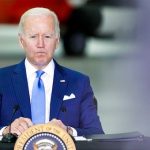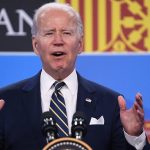President Biden’s student debt relief plan is being panned by Democrats, Republicans, and everyone in between.
But the most disheartening criticism for Mr. Biden came from his moderate Democratic allies who historically are most closely aligned with him.
Rep. Jared Golden, Maine Democrat, called the up to $20,000 of college loan forgiveness “out of touch with what the majority of people want for the White House” in stinging remarks published in the Bangor Daily News.
“It’s not how I would have addressed the issue,” Rep. Sharice Davids told the Kansas City Star. She called for instead making higher education and technical schools more affordable, which are the types of solutions Mr. Biden once championed.
Rep. Tim Ryan, an Ohio Democrat vying for U.S. Senate, told the Columbus Dispatch: “Waiving debt for those already on a trajectory to financial security sends the wrong message to the millions of Ohioans without a degree working just as hard to make ends meet.”
The criticism from those most closely aligned to the president piled on to the complaints from the far left and the right.
SEE ALSO: Democratic voters say Biden momentum turning around midterm expectations
Progressives said Mr. Biden didn’t do enough. They wanted him to cancel $50,000 or more per borrower. Republicans said the bailout, which is estimated to cost taxpayers as much as $600 billion, would mostly benefit wealthy people.
They also faulted it for being more out-of-control spending from the president and his Democrats in Congress, which Republicans insist is a key driver behind inflation.
The only ones who were happy, it seemed, were those college students and graduates poised to write off $10,000 or $20,000 of the debt amassed to pay for their education.
“One of the surprising things is how the centrist or moderate Democrats are having to deal with it,” said aid Timothy Hagle, a political science professor at the University of Iowa. “The concern is a combination of who is going to pay for it and the idea that maybe this forgiveness isn’t targeted well enough.”
“There are a lot of issues going on here,” he said.
The long-awaited plan unveiled Wednesday included canceling $10,000 in student debt for borrowers who earn less than $125,000 per year and $20,000 in debt for those who received Pell Grants. Mr. Biden also extended the pause on federal student loan payments through December.
SEE ALSO: House GOP: Facebook flagged our posts about Biden canceling student debt
The Biden plan lowers monthly payments on outstanding undergraduate loans from 10% to 5% of discretionary income and forgives loan balances after 10 years of payments instead of the current 20 years for original loan balances of $12,000 or less.
The debt forgiveness, which Mr. Biden promised during his 2020 run for the White House, was rolled out as Democrats eye a challenging midterm election cycle. It’s also certain to attract the attention of young voters.
Former President Donald Trump, a reliable critic of Mr. Biden, assailed the plan as an attempt to buy votes for Democrats, dubbing it an “election enhancing money grab.”
“Crippling inflation, unaffordable energy prices, and WAR —all things that should never have happened,” Mr. Trump said. “But if that wasn’t enough, now Americans are bailing out College Administrators who fleeced students, and those who opted for Degrees there was no way they could afford.”
“America is a nation in decline, and the cliff into oblivion is within sight,” he said. “Stop voting for Democrats!”
The plan is not a done deal, however, as it is expected to spur legal challenges over whether the president has the authority to cancel the taxpayer-financed loans with the stroke of a pen.
Secretary of Education Michael Cardona invoked the COVID-19 pandemic in his memo outlining the administration’s authority to cancel student debt. That same authority was used by the Trump administration when it paused student debt repayment during the height of the pandemic.
Mr. Biden‘s opponents, and some Democrats, argued that student loan cancellation is a form of government spending and Congress, not the executive branch, controls the purse strings.
“There are often times when an administration, whether it’s Democrat or Republican, it doesn’t matter, when they make a decision that’s not going to make anyone happy,” Mr. Hagle said. “But the administration should be aware of the messaging, and they just did not do a good job on this one.”
In rolling out the plan, Mr. Biden said the widespread relief would reverberate across the entire economy, by allowing those saddled by high debt loads to “crawl out from under that mountain of debt, to get on top of their rent and utilities, to finally think about buying a home or starting a family or starting a business.”
More than $124 billion, or approximately 8% of student debt, is in default, according to a December report by the Education Data Initiative. An average of 15% of student loans are in default at any given time, and more than 1 million student loans enter default each year.
More than 43 million Americans hold federal student debt, with an average balance of $37,667, according to federal figures.
Administration officials expect up to 20 million people to have their student debt completely forgiven under the plan.
Mr. Biden has yet to say how much the plan will ultimately cost, or lay out a plan to bring down skyrocketing tuition rates.
The proposed changes do not reduce the amount of borrowing going forward, which will place future administrations under pressure to cancel student loan debt again.
The nonpartisan think tank Committee for a Responsible Federal Budget projected that the student loan bailout will eliminate $550 billion from the current outstanding debt balance of $1.6 trillion in the immediate term, but that the debt will return to current highs as college students continue to borrow.
And the plan comes at a significant cost to taxpayers, according to the analysis.
Mr. Biden‘s plan was projected to cost taxpayers between $440 billion and $600 billion over the next decade, eliminating any deflationary benefit derived from the tax hikes in the spending and tax bill that Democrats named the Inflation Reduction Act.
That figure does not include the cost associated with the pause on student loan repayments since the start of the pandemic, which the think tank estimates to have cost roughly $800 billion.
“It is extremely troubling to see the Administration reverse the legislative progress made on deficit reduction,” the think tank’s report reads. “It is long past time that student debt repayments resume, and now it is even more important for policymakers to enact changes that reduce deficits through spending reductions and revenue increases in order to put the national debt on a downward sustainable path.”
Mr. Biden responded to critics by saying his administration is “taking an economically responsible course.”
“I understand not everything I’m announcing today is going to make everybody happy,” Mr. Biden said during a White House address. “But I believe my plan is responsible and fair. It focuses the benefit on the middle class and working families. And it will fix a badly broken system.”


